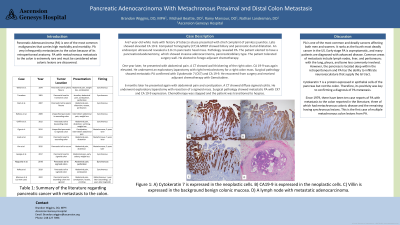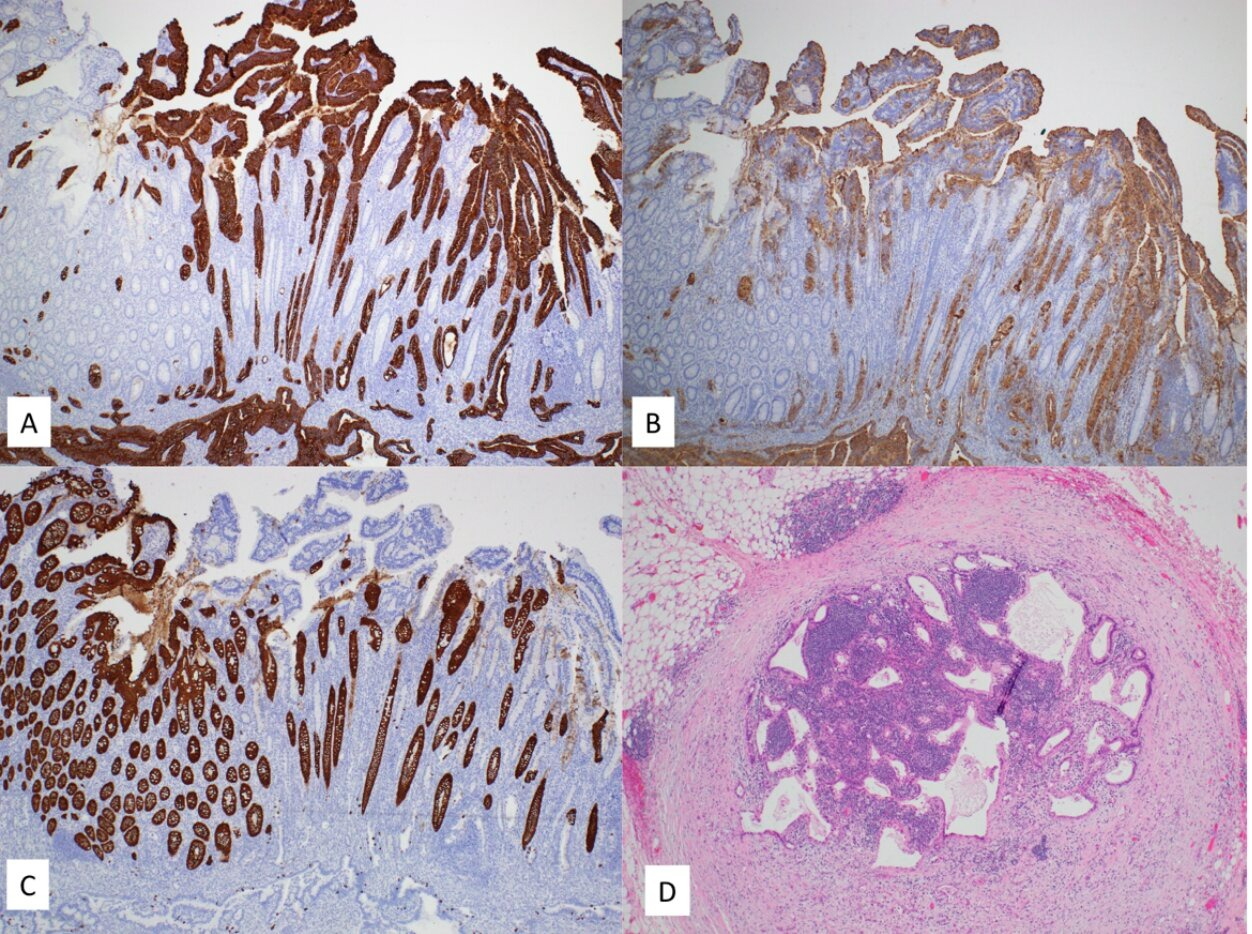Back


Poster Session B - Monday Morning
Category: Biliary/Pancreas
B0041 - Pancreatic Adenocarcinoma With Metachronous Proximal and Distal Colon Metastasis
Monday, October 24, 2022
10:00 AM – 12:00 PM ET
Location: Crown Ballroom

Has Audio

Brandon Wiggins, DO, MPH
Ascension Genesys Hospital
Grand Blanc, MI
Presenting Author(s)
Brandon Wiggins, DO, MPH, Michael Beattie, DO, Ramy Mansour, DO, Nathan Landesman, DO
Ascension Genesys Hospital, Grand Blanc, MI
Introduction: Pancreatic Adenocarcinoma (PA) is one of the most common malignancies that carries high morbidity and mortality. PA very infrequently metastasizes to the colon because of its retroperitoneal anatomy. PA with metachronous metastasis to the colon is extremely rare and must be considered when colonic lesions are discovered.
Case Description/Methods: A 67 year old white male with history of tobacco abuse presented with chief complaint of painless jaundice. Labs showed elevated CA 19-9. Computed Tomography (CT) & MRCP showed biliary and pancreatic ductal dilatation. An endoscopic ultrasound revealed a 2.8 cm pancreatic head mass. Pathology revealed PA. The patient elected to have a pancreaticoduodenectomy, which showed invasive adenocarcinoma, pancreaticobiliary type. The patient tolerated surgery well. He elected to forgo adjuvant chemotherapy.
One year later, he presented with abdominal pain. A CT showed wall thickening of the right colon. CA 19-9 was again elevated. He underwent an exploratory laparotomy with right hemicolectomy for a right colon mass. Surgical pathology showed metastatic PA confirmed with Cytokeratin 7 (CK7) and CA 19-9. He recovered from surgery and received adjuvant chemotherapy with Gemcitabine.
6 months later he presented again with abdominal pain and constipation. A CT showed diffuse sigmoid colitis. He underwent exploratory laparotomy with resection of a sigmoid mass. Surgical pathology showed metastatic PA with CK7 and CA 19-9 expression. Chemotherapy was stopped and the patient was transitioned to hospice.
Discussion: PA is one of the most common and deadly cancers affecting both men and women. It ranks as the fourth most deadly cancer in the US. Early stage PA is asymptomatic, and many patients are diagnosed with advanced disease. Common areas of metastasis include lymph nodes, liver, and peritoneum; with the lung, pleura, and bone less commonly involved. However, the pancreas is located deep within the retroperitoneum and PA has the ability to infiltrate neurovasculature that supply the GI tract.
Cytokeratin 7 is a protein expressed in epithelial cells of the pancreas but not the colon. Therefore, its positivity was key to confirming a diagnosis of PA metastasis.
Since 1979, there have been ten case reports of PA with metastasis to the colon reported in the literature, three of which had metachronous colonic disease and the remaining having synchronous lesions. This is the first case of multiple metachronous colon lesions from PA.

Disclosures:
Brandon Wiggins, DO, MPH, Michael Beattie, DO, Ramy Mansour, DO, Nathan Landesman, DO. B0041 - Pancreatic Adenocarcinoma With Metachronous Proximal and Distal Colon Metastasis, ACG 2022 Annual Scientific Meeting Abstracts. Charlotte, NC: American College of Gastroenterology.
Ascension Genesys Hospital, Grand Blanc, MI
Introduction: Pancreatic Adenocarcinoma (PA) is one of the most common malignancies that carries high morbidity and mortality. PA very infrequently metastasizes to the colon because of its retroperitoneal anatomy. PA with metachronous metastasis to the colon is extremely rare and must be considered when colonic lesions are discovered.
Case Description/Methods: A 67 year old white male with history of tobacco abuse presented with chief complaint of painless jaundice. Labs showed elevated CA 19-9. Computed Tomography (CT) & MRCP showed biliary and pancreatic ductal dilatation. An endoscopic ultrasound revealed a 2.8 cm pancreatic head mass. Pathology revealed PA. The patient elected to have a pancreaticoduodenectomy, which showed invasive adenocarcinoma, pancreaticobiliary type. The patient tolerated surgery well. He elected to forgo adjuvant chemotherapy.
One year later, he presented with abdominal pain. A CT showed wall thickening of the right colon. CA 19-9 was again elevated. He underwent an exploratory laparotomy with right hemicolectomy for a right colon mass. Surgical pathology showed metastatic PA confirmed with Cytokeratin 7 (CK7) and CA 19-9. He recovered from surgery and received adjuvant chemotherapy with Gemcitabine.
6 months later he presented again with abdominal pain and constipation. A CT showed diffuse sigmoid colitis. He underwent exploratory laparotomy with resection of a sigmoid mass. Surgical pathology showed metastatic PA with CK7 and CA 19-9 expression. Chemotherapy was stopped and the patient was transitioned to hospice.
Discussion: PA is one of the most common and deadly cancers affecting both men and women. It ranks as the fourth most deadly cancer in the US. Early stage PA is asymptomatic, and many patients are diagnosed with advanced disease. Common areas of metastasis include lymph nodes, liver, and peritoneum; with the lung, pleura, and bone less commonly involved. However, the pancreas is located deep within the retroperitoneum and PA has the ability to infiltrate neurovasculature that supply the GI tract.
Cytokeratin 7 is a protein expressed in epithelial cells of the pancreas but not the colon. Therefore, its positivity was key to confirming a diagnosis of PA metastasis.
Since 1979, there have been ten case reports of PA with metastasis to the colon reported in the literature, three of which had metachronous colonic disease and the remaining having synchronous lesions. This is the first case of multiple metachronous colon lesions from PA.

Figure: A) Cytokeratin 7 is expressed in the neoplastic cells (40X). B) CA19-9 is expressed in the neoplastic cells (40X). C) Villin is expressed in the background benign colonic mucosa (40X). D) A lymph node with metastatic adenocarcinoma.
Disclosures:
Brandon Wiggins indicated no relevant financial relationships.
Michael Beattie indicated no relevant financial relationships.
Ramy Mansour indicated no relevant financial relationships.
Nathan Landesman: Abbvie – Advisory Committee/Board Member. AMBU – Speakers Bureau. medtronic – Advisory Committee/Board Member. pfizer – Advisory Committee/Board Member. RedHill – Advisory Committee/Board Member, Speakers Bureau.
Brandon Wiggins, DO, MPH, Michael Beattie, DO, Ramy Mansour, DO, Nathan Landesman, DO. B0041 - Pancreatic Adenocarcinoma With Metachronous Proximal and Distal Colon Metastasis, ACG 2022 Annual Scientific Meeting Abstracts. Charlotte, NC: American College of Gastroenterology.
